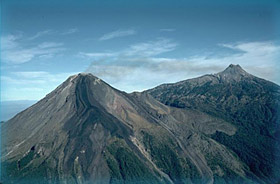 |
 |
 |
 Editorials | Environmental | June 2005 Editorials | Environmental | June 2005  
Mexican Volcano Fires Up
 Kathryn Hansen - Geotimes Kathryn Hansen - Geotimes


| | Volcān de Colima (left) emits steam even on a relatively calm day. Nevado de Colima (right) is not as active as its neighbor, but remains the taller of the two at 4,240 meters above sea level. (Photo: James Allan/Smithsonian) |
Residents of the villages near the Volcān de Colima in the Mexican state of Jalisco know what it's like to live in the dangerous shadow of the most active volcano in Mexico, which has erupted more than 40 times since 1576. But this week's eruption exceeded the magnitude of all minor events in the last 20 years. And if history repeats itself, some geologists fear the recent activity could be only the beginning of a larger event to come one that could parallel or exceed the damage caused by its last major eruption in 1913, which turned the summit into a 500-meter-deep crater and blew ash 125 kilometers north into Guadalajara.

At about 11 p.m. local time Monday, June 6, Colima volcano erupted, producing an avalanche of ash and rock, in addition to an ash plume that rose to an elevation of 5 kilometers (16,400 feet) above the top of the volcano. The plume spread and blanketed nearby villages, Tonila and San Marcos, in a layer of ash, according to an AP report. Evacuation was not mandatory, but officials restricted access within an 11.5-kilometer radius from the summit and warned residents 30 kilometers away in the city of Colima to wear masks.

"The eruption Monday sent a lot of ash into the city, causing respiratory problems," says Jim Luhr, director of the Smithsonian Institution's Global Volcanism Program. "But that's the least of their worries." What researchers and the surrounding communities fear most is a total collapse of the volcanic caldera.

The volcano, sometimes also called Volcān Fuego (or Fire Volcano), grows from a 5-kilometer-wide circular depression at the center of the Mexican Volcanic Belt. The volcano's conical shape was built by the eruption of ash flows, but repeated slope failures created an "apron" of debris around the base. Luhr says that he is concerned that this base, on which some communities have been built, might no longer be stable and could face an impending collapse.

According to Luhr, many collapses have occured in the history of Colima, the last one 3,500 years ago. "The deposit is as high as it has ever been," Luhr says. Also, researchers say that the deposit has taken on a pink, rust coloration, which means that volcanic gases have altered the slope. "This commonly feared pastel coloring," Luhr says, "indicates a weakness in the deposit and the potential for a collapse."

But a collapse of the mountain is the worst of three possible future scenarios posed by the University of Colima's volcano observatory. A second scenario is a smaller version of Monday's eruption, in which avalanches would travel out to about 5 kilometers and pile more ash on nearby cities. A third scenario involves an enormous eruption on the scale of the 1913 blast. Even in this case, however, the city of Colima just south of the volcano would not be in much danger, Luhr says, because typical wind patterns move north. "But anything can happen and winds can change," Luhr says. The cloud from Monday's eruption moved southwest.

Geologists look to the composition of ejecta during various episodes to determine the potential threat. The current episode of activity began in 1998, which included the growth of the lava dome, flows of lava and ash, and multiple eruptions. Researchers found that new magma had been produced during these events, Luhr says. But for an explosion on the scale of the 1913 event to occur, the magma must retain water until it reaches the surface. Since 1913, water vapor has always beaten the magma to the surface. "You could see gases streaming out before the magma," he says.

Colima's behavior is likely cyclic, Luhr says, and current events are similar to those that preceded the 1913 explosion. The question remains as to why the magma sometimes retains gas and, other times, it bleeds out, he says. "We still don't know if Colima is gas-rich or not." The only way for researchers to find out is to evaluate samples of recent ejecta. Ejecta with a glassy composition, for example, would imply that gas-infused magma reached the surface and that Colima has "entered a new phase," Luhr says. "The people surrounding Colima could have quite a dangerous situation on their hands."

In the meantime, the University of Colima's volcano observatory issued reports that local villages should remain on alert and under voluntary evacuation. Luhr says that residents of La Yerbabuena the closest community to Volcān de Colima previously signed a petition that would waive any evacuation by the army. Residents grew tired of multiple after-the-fact evacuations during the period of high activity beginning in 1998. Monday's eruption was just another event in "a long and tortuous experience for these people," Luhr says. | 
 | |
 |



